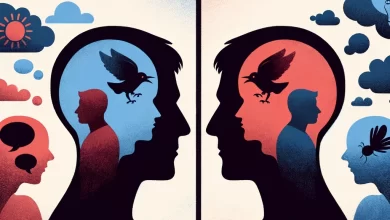Understanding Anxiety: Causes & Relief Options
Do you ever find yourself overwhelmed by feelings of fear and uncertainty that interfere with your daily activities? If so, you’re not alone. Anxiety disorders affect nearly 1 in 5 American adults each year, making it a prevalent mental health issue that demands attention and understanding.
Anxiety is the body’s natural response to stress. While it can be helpful in certain situations, excessive anxiety can have a debilitating impact on mental well-being. It can leave individuals feeling trapped and unable to cope, affecting their relationships, work, and overall quality of life.
In this article, we will delve into the complex world of anxiety, exploring the causes behind it and the various relief options available. From therapy and mindfulness techniques to relaxation exercises and self-care practices, we’ll uncover effective strategies to help you manage anxiety and regain control over your daily life.
Key Takeaways:
- Anxiety disorders affect nearly 1 in 5 American adults each year.
- Excessive anxiety can interfere with daily activities and overall well-being.
- Understanding the causes of anxiety can help in finding appropriate relief options.
- Therapy, mindfulness, relaxation techniques, and self-care practices are effective in managing anxiety.
- Seeking help from healthcare professionals is essential for accurate diagnosis and effective treatment.
The Impact of Anxiety Disorders on Daily Life
Anxiety disorders can profoundly affect an individual’s daily life, making even the simplest everyday activities sources of distress and agitation. The constant state of anxiety associated with these disorders can disrupt work, school, relationships, and leisure activities, preventing individuals from fully participating in and enjoying life.
These disorders not only impact daily functioning but can also contribute to the development of other medical problems. Research has shown a clear link between anxiety disorders and a higher risk of conditions such as heart disease, diabetes, substance abuse, and depression. The relentless stress and strain that anxiety places on the body can have a detrimental effect on physical health, exacerbating existing medical conditions and increasing susceptibility to new ones.
“Living with an untreated anxiety disorder is like navigating life with endless roadblocks. It feels like you’re constantly trying to keep up, but your anxiety always manages to get in the way.”
– Jennifer, anxiety disorder survivor
However, the positive news is that anxiety disorders are highly treatable, and most individuals can find relief from their symptoms with appropriate treatment. Seeking professional help and receiving the right treatment can make a significant difference in managing anxiety and reclaiming control over one’s life.
The key to effective treatment lies in comprehensive and personalized approaches that address both the physical and psychological aspects of anxiety disorders. This can include a combination of therapy, medication, and self-care practices. Therapy sessions with licensed mental health professionals, such as cognitive-behavioral therapy (CBT), can help individuals develop coping strategies, challenge negative thoughts, and gradually confront their fears and anxieties to regain confidence and control.
In some cases, medication may be prescribed to alleviate severe symptoms or as a complementary treatment to therapy. While medication can be beneficial in managing anxiety, it is crucial to work closely with medical professionals to find the right medication and dosage that suits an individual’s needs.
Additionally, adopting self-care practices can greatly enhance the effectiveness of professional treatment. Engaging in activities that promote relaxation, self-reflection, exercise, and adequate sleep can contribute to overall well-being and reduce anxiety levels.
Anxiety Treatment Options
| Treatment | Description |
|---|---|
| Therapy | Individual or group sessions with licensed mental health professionals, such as cognitive-behavioral therapy (CBT), psychotherapy, or exposure therapy. |
| Medication | Prescribed medication, such as selective serotonin reuptake inhibitors (SSRIs) or benzodiazepines, to manage symptoms and support psychological treatment. |
| Self-care | Engaging in activities that promote relaxation, stress reduction, and overall well-being, such as exercise, meditation, deep breathing, and maintaining a balanced lifestyle. |
By addressing anxiety disorders through a combination of therapy, medication, and self-care practices, individuals can regain control of their lives and experience relief from the emotional and physical burdens of anxiety. Seeking help and support is the first step towards a brighter future free from the constraints of anxiety’s grip.
Common Types of Anxiety Disorders
Anxiety disorders are prevalent and can have a significant impact on individuals’ lives. Three common types of anxiety disorders are social anxiety disorder, generalized anxiety disorder, and panic disorder. Each of these disorders presents unique symptoms and affects individuals differently.
Social Anxiety Disorder
Social anxiety disorder, also known as social phobia, affects approximately 15 million adults in the United States. It is characterized by excessive fear and self-consciousness in social situations. Individuals with social anxiety disorder often have an intense fear of being judged, humiliated, or embarrassed. Everyday activities such as public speaking, eating in front of others, or participating in social gatherings can evoke intense anxiety and discomfort.
Generalized Anxiety Disorder
Generalized anxiety disorder is one of the most common anxiety disorders, affecting around 7 million American adults. Individuals with this disorder experience excessive worry and anxiety about various aspects of their lives, such as work, health, finances, and relationships. They may have difficulty controlling their worrying and often anticipate negative outcomes. Physical symptoms, such as restlessness, muscle tension, and fatigue, are also common.
Panic Disorder
Panic disorder is characterized by recurring panic attacks, sudden episodes of intense fear and discomfort. Approximately 6 million individuals in the United States live with panic disorder. Panic attacks can occur unexpectedly and without a clear trigger, leading to overwhelming physical sensations, such as a racing heart, shortness of breath, trembling, and a sense of impending doom. The fear of experiencing future panic attacks can significantly impact daily activities and may lead to the avoidance of certain situations.
It is important to note that while these anxiety disorders affect both men and women, there are variations in prevalence between genders. Women tend to be more commonly diagnosed with anxiety disorders, including social anxiety disorder, generalized anxiety disorder, and panic disorder. Understanding and recognizing these common anxiety disorders is crucial in seeking appropriate diagnosis and treatment.
| Anxiety Disorder | Prevalence | Characteristics | Impact |
|---|---|---|---|
| Social Anxiety Disorder | Affects approximately 15 million US adults* | Excessive fear and self-consciousness in social situations | Interferes with everyday activities and social interactions |
| Generalized Anxiety Disorder | Affects around 7 million US adults* | Excessive worry, physical symptoms, difficulty controlling worrying | Disrupts daily functioning, impacts overall well-being |
| Panic Disorder | Affects approximately 6 million individuals in the US* | Recurring panic attacks, intense fear, physical sensations | Impairs daily activities, may lead to avoidance behaviors |
*Statistics may vary
Factors Influencing Anxiety Disorders
Anxiety disorders are complex conditions influenced by various factors, including genetics, stress, environment, childhood experiences, and mental health disorders. While no specific genes causing anxiety disorders have been identified, research suggests that a combination of genetic predisposition and environmental factors contribute to their development.
One of the significant factors that can contribute to the development of anxiety disorders is stress. High levels of chronic stress, such as ongoing pressure at work or personal difficulties, can increase the risk of developing anxiety symptoms. Stressful life events, such as trauma or loss, can also trigger the onset of anxiety disorders.
Environmental factors, such as upbringing and early life experiences, play a crucial role in shaping an individual’s vulnerability to anxiety disorders. Childhood experiences, such as adverse childhood events or a chaotic home environment, can increase the risk of developing anxiety later in life.
It is essential to recognize that anxiety disorders often begin in childhood and continue into adulthood. According to research, approximately 1 in 3 children experiences anxiety at some point. Childhood anxiety can have long-lasting effects if left untreated, highlighting the importance of early intervention and support.
“Factors like genetics, stress, environment, and childhood experiences all contribute to the development of anxiety disorders. Understanding these influences is crucial in providing appropriate interventions and support.”
Recognizing these influencing factors can help healthcare professionals tailor treatment strategies and interventions to meet the specific needs of individuals with anxiety disorders. By addressing the underlying genetic, environmental, and childhood factors, it becomes possible to provide comprehensive and personalized care.
The Role of Genetics
While specific genes causing anxiety disorders have not been identified, research suggests a genetic component to their development. Family studies have shown that anxiety disorders tend to run in families, suggesting a hereditary influence.
It is important to note that genetics alone do not cause anxiety disorders. Rather, they contribute to an individual’s susceptibility to developing these conditions. Other factors, such as environment and stress, interact with genetic predisposition to determine the likelihood of anxiety disorder onset.
Effects of Stress and Environment
Stressful life events and chronic stress can significantly impact an individual’s mental well-being. They can contribute to the development of anxiety disorders by triggering the body’s stress response systems and disrupting the brain’s neurochemical balance. High-stress levels can increase anxiety symptoms and make it more challenging to cope with daily life.
The environment in which one grows up or lives can also play a role in the development of anxiety disorders. Factors such as socioeconomic status, exposure to violence or abuse, and family dynamics can influence an individual’s risk for anxiety. Creating a supportive and nurturing environment is vital in mitigating these risks and promoting mental well-being.
Childhood Experiences and Mental Health Disorders
Childhood experiences, particularly adverse events, can impact an individual’s mental health in various ways. Traumatic experiences, abuse, neglect, or witnessing violence can increase the risk of developing anxiety disorders in adulthood.
Additionally, having a family history of mental health disorders, such as depression or anxiety, can further increase an individual’s susceptibility to developing anxiety. This suggests the interplay between genetic and environmental factors in shaping an individual’s mental health.
| Factors Influencing Anxiety Disorders | Description |
|---|---|
| Genetics | Family history and genetic predisposition to anxiety disorders |
| Stress | Chronic stress and stressful life events |
| Environment | Upbringing, early life experiences, and environmental factors |
| Childhood | Early childhood experiences and exposure to trauma or adverse events |
| Mental Health Disorders | Family history of mental health disorders, such as depression or anxiety |
Brain Imaging and Anxiety Disorders
Brain imaging studies play a crucial role in advancing our understanding of anxiety disorders and their underlying mechanisms. One such groundbreaking study was conducted by Dr. Susan Whitfield-Gabrieli, who received funding from the National Institutes of Health (NIH) to investigate the brain structures and activities associated with anxiety disorders.
The use of magnetic resonance imaging (MRI) in these studies allows researchers to visualize the brain in incredible detail, providing valuable insights into how the brain functions in individuals with anxiety disorders. By examining brain connections and neural pathways, researchers aim to identify patterns that may help predict an individual’s treatment response to cognitive-behavioral therapy (CBT), a widely used therapy for anxiety disorders.
Understanding the specific brain regions and networks involved in anxiety disorders can help tailor treatment approaches to each individual’s unique needs. By utilizing brain imaging techniques, healthcare professionals can gain a deeper understanding of the neural mechanisms underlying anxiety and provide more targeted and effective treatment strategies.
“Brain imaging studies offer a window into the inner workings of the brain, enabling us to identify the specific brain regions and connections associated with anxiety disorders. This knowledge can guide the development of personalized treatment plans that address the root causes of anxiety.” – Dr. Susan Whitfield-Gabrieli
The Potential of Brain Imaging in Tailoring Treatment
Brain imaging studies have the potential to revolutionize the way we approach the treatment of anxiety disorders. By identifying the neural signatures that are predictive of treatment response, healthcare professionals can develop personalized treatment plans that are most likely to alleviate an individual’s symptoms.
Through a detailed analysis of brain connections and activity patterns, researchers can identify biomarkers that can guide treatment decisions. For example, if a brain imaging study shows abnormal connectivity in certain regions associated with anxiety, healthcare professionals may recommend targeted interventions or pharmacological approaches to normalize those connections.
| Treatment Response Biomarkers | Potential Treatment Approach |
|---|---|
| Enhanced connectivity in prefrontal cortex | Cognitive-behavioral therapy (CBT) |
| Reduced connectivity in amygdala | Exposure therapy |
| Altered glutamate levels | Pharmacological intervention |
By integrating brain imaging findings with clinical assessments, healthcare professionals can develop comprehensive treatment plans that address both the cognitive and physiological aspects of anxiety disorders. This multidimensional approach holds immense promise in improving treatment outcomes and helping individuals overcome the challenges posed by anxiety disorders.
As brain imaging techniques continue to advance, our ability to understand the intricate workings of the brain and its role in anxiety disorders will further deepen. This ongoing research has the potential to unlock new therapeutic targets, leading to more effective treatments and improved quality of life for individuals living with anxiety disorders.
Emotion Regulation and Anxiety
Understanding how individuals with anxiety disorders regulate their emotions is a key focus of ongoing research conducted by experts like Dr. James Gross. Emotion regulation strategies play a significant role in helping individuals manage their anxiety and enhance their overall well-being.
Cognitive-behavioral therapy (CBT) has proven to be an effective treatment option for anxiety disorders. It empowers individuals by teaching them practical techniques to recognize and modify their emotional responses. Through CBT, individuals with anxiety disorders learn how to identify and challenge negative thought patterns, replace them with more rational and positive thoughts, and implement coping strategies to regulate their emotions effectively.
By acquiring these emotion regulation strategies, individuals gain a greater understanding of their emotions and develop the skills to navigate through anxiety-provoking situations with greater ease. They can effectively manage their anxiety symptoms and reduce the impact of anxiety on their daily lives.
“Cognitive-behavioral therapy equips individuals with anxiety disorders with the tools needed to effectively regulate their emotions. By focusing on identifying and modifying maladaptive thoughts and behaviors, this therapeutic approach promotes positive emotional well-being.” – Dr. James Gross
Through targeted therapy sessions, individuals can build resilience, enhance self-awareness, and gain a sense of control over their emotions. The integration of proven emotion regulation techniques equips individuals with anxiety disorders to better navigate everyday challenges, reducing the negative impact anxiety can have on their overall mental health.
Research Insights: Cognitive-Behavioral Therapy (CBT)
Studies have shown that cognitive-behavioral therapy, in combination with other treatment modalities, has a significant positive impact on individuals with anxiety disorders. Noteworthy research findings on the effectiveness of CBT include:
| Study | Findings |
|---|---|
| Study 1 | CBT resulted in a reduction in anxiety symptoms in 75% of participants, with long-term benefits observed. |
| Study 2 | Individuals receiving CBT reported improved emotional regulation and a decreased reliance on maladaptive coping mechanisms. |
| Study 3 | CBT demonstrated efficacy in reducing anxiety levels and enhancing overall well-being, leading to improved quality of life. |
These research findings highlight the effectiveness of cognitive-behavioral therapy in managing anxiety disorders and improving emotional regulation. CBT provides individuals with practical tools to develop healthier emotional responses, leading to greater overall mental well-being and an improved ability to navigate life challenges.
Available Treatments for Anxiety Disorders
Anxiety disorders can be effectively managed through various treatment options. The most common treatments include psychotherapy and medication. Psychotherapy, such as cognitive-behavioral therapy (CBT), is a widely recognized form of therapy for anxiety disorders. It focuses on identifying and changing negative thought patterns and behaviors that contribute to anxiety. Through CBT, individuals learn practical coping skills and strategies to manage their anxiety.
Medications also play a significant role in treating anxiety disorders. Anti-anxiety medications, such as benzodiazepines, can help reduce symptoms of anxiety and promote relaxation. Selective serotonin reuptake inhibitors (SSRIs) are another commonly prescribed medication for anxiety disorders. These medications work by balancing brain chemicals that affect mood and anxiety.
When considering treatment options for anxiety disorders, it is important to consult with a healthcare professional. A physician or psychiatrist can evaluate the severity of the anxiety disorder and determine the most appropriate treatment approach. They will consider factors such as the individual’s overall health, medical history, and any potential interactions with other medications or conditions.
Collaborating with healthcare professionals ensures that treatment plans are tailored to the specific needs of the individual. They can provide guidance and monitor the effectiveness of the chosen treatment, making adjustments as necessary. It is also essential to communicate any concerns or side effects experienced during the treatment process to ensure optimal care and outcomes.
In addition to psychotherapy and medications, individuals with anxiety disorders may benefit from other healthcare professionals. For example, a counselor or therapist specializing in anxiety disorders can provide support and guidance throughout the treatment journey. They can assist in developing personalized coping strategies, managing stress, and addressing any underlying psychological factors contributing to anxiety.
Overall, the combination of psychotherapy, medications, and collaboration with healthcare professionals offers a comprehensive approach to managing anxiety disorders. By seeking appropriate treatment and support, individuals can regain control of their lives and experience relief from the debilitating symptoms of anxiety.
According to a study published in the Journal of Clinical Psychology, cognitive-behavioral therapy (CBT) has shown significant efficacy in reducing anxiety symptoms and improving overall well-being in individuals with anxiety disorders.
What Is Anxiety and How It Impacts Daily Life
Anxiety is the body’s natural reaction to stress, helping us respond to potential danger. It is a normal and necessary emotion that prepares us to take action in threatening situations. When faced with a stressful or threatening event, anxiety triggers a physiological response known as the fight-or-flight response. This response involves the release of stress hormones, increased heart rate, heightened awareness, and a surge of adrenaline, all preparing the body to face the perceived threat.
While anxiety serves a vital purpose in our survival, excessive and persistent anxiety can have a significant impact on daily life. When anxiety becomes overwhelming and interferes with our ability to function and cope with everyday activities, it can be classified as an anxiety disorder. Anxiety disorders are characterized by persistent feelings of fear, worry, and apprehension that are out of proportion to the actual threat or situation. These feelings may be accompanied by physical symptoms such as racing heart, shortness of breath, sweating, and trembling.
The impact of anxiety on daily life can be profound. It can lead to difficulties in concentration, memory, decision-making, and problem-solving, affecting academic performance, work productivity, and personal relationships. Anxiety can also disrupt sleep patterns, leading to fatigue and exhaustion, which further exacerbate the symptoms. Additionally, anxiety can cause avoidance behaviors, where individuals try to escape or avoid situations that trigger their anxiety, further limiting their engagement in various activities.
| Anxiety Symptoms | Impact on Daily Life |
|---|---|
| Excessive worry | Difficulty focusing on tasks |
| Restlessness | Interrupted sleep and fatigue |
| Irritability | Strained relationships |
| Increased heart rate | Difficulty engaging in social activities |
| Shortness of breath | Impaired performance at work or school |
To adequately address anxiety and minimize its impact on daily life, seeking appropriate help and support is essential. Treatment options for anxiety disorders can include therapy, medication, and holistic approaches such as relaxation techniques and mindfulness practices. A combination of these approaches is often the most effective in managing symptoms and improving overall well-being.
By understanding anxiety and its effects, individuals can take the necessary steps to seek professional help, develop healthy coping mechanisms, and engage in self-care practices that promote emotional well-being. With the right support and treatment, individuals can regain control over their anxiety and lead fulfilling and productive lives.
Common Anxiety Disorders and Their Symptoms
Anxiety disorders encompass a range of conditions that can significantly impact individuals’ well-being and quality of life. Understanding the various types of anxiety disorders and their associated symptoms is crucial for accurate diagnosis and effective treatment.
1. Generalized Anxiety Disorder (GAD)
Generalized anxiety disorder is characterized by excessive worry and anxiety about everyday life events or activities. The symptoms of GAD may include:
- Constant worrying or feeling on edge
- Restlessness or irritability
- Trouble concentrating or sleeping
- Muscle tension
- Fatigue
2. Panic Disorder
Panic disorder is characterized by recurrent and unexpected panic attacks, which are intense episodes of fear or discomfort. The symptoms of panic disorder may include:
- Sudden and overwhelming feelings of panic or dread
- Accelerated heart rate or palpitations
- Shortness of breath or hyperventilation
- Chest pain or discomfort
- Dizziness or lightheadedness
3. Social Anxiety Disorder
Social anxiety disorder is characterized by an intense fear of social situations and excessive self-consciousness. The symptoms of social anxiety disorder may include:
- Fear of being humiliated, embarrassed, or judged by others
- Avoidance of social situations or difficulty speaking in public
- Excessive self-doubt or negative self-image
- Sweating, trembling, or blushing in social situations
4. Separation Anxiety
Separation anxiety is commonly observed in children but can also affect adults. It involves excessive fear or worry about being separated from a specific person or attachment figure. The symptoms of separation anxiety may include:
- Excessive distress when anticipating or experiencing separation
- Preoccupation with the well-being of the attachment figure
- Nightmares or difficulty sleeping away from the attachment figure
- Reluctance or refusal to leave the attachment figure
5. Phobias
Phobias are characterized by an intense and irrational fear of specific objects, situations, or activities. The symptoms of phobias may include:
- Extreme fear or anxiety when exposed to the phobic stimulus
- Avoidance of the phobic stimulus or enduring it with intense distress
- Physical symptoms, such as trembling, rapid heartbeat, or sweating
- Anticipatory anxiety when thinking about or encountering the phobic stimulus
It’s important to remember that anxiety disorders can manifest differently in each individual. Professional evaluation and diagnosis by a qualified healthcare provider are vital for accurate identification and treatment of these conditions.
In addition to the aforementioned anxiety disorders, there are other less common types such as obsessive-compulsive disorder (OCD), post-traumatic stress disorder (PTSD), and specific phobias. While the symptoms may differ, seeking professional help for any anxiety-related concerns is crucial for appropriate diagnosis and access to effective treatment options.
Conclusion
Anxiety is a common condition that can significantly impact mental health and daily functioning. It affects nearly 20% of American adults and can interfere with everyday activities, leading to feelings of fear and uncertainty. However, there are effective relief options available for individuals with anxiety disorders.
Therapy and medication are two main methods used to treat anxiety. Psychotherapy, such as cognitive-behavioral therapy (CBT), can help individuals develop coping mechanisms, manage stress, and navigate challenging situations. Medication, prescribed by healthcare professionals, can provide additional support in reducing symptoms of anxiety.
With the right treatment and support, individuals with anxiety disorders can lead fulfilling and successful lives. It is crucial to seek help from healthcare professionals to receive appropriate care for anxiety disorders. Addressing mental health concerns is essential for overall well-being and maintaining a good quality of life.
If you or someone you know is experiencing anxiety symptoms, reach out to a healthcare provider for assistance and guidance. Remember, you are not alone, and there are resources available to help navigate through anxiety and find relief options that work best for you.






